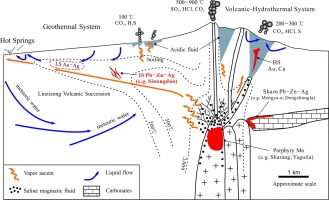Geology, geochronology, and geochemistry of the Sinongduo Ag–Pb–Zn deposit in the Gangdese Metallogenic Belt: Implications of intermediate sulfidation mineralization in the Linzizong volcanic succession

The Sinongduo Ag–Pb–Zn deposit was first defined as a typical low sulfidation (LS) epithermal deposit in the widespread Linzizong volcanic succession (LVS), Gangdese belt, Tibet. This paper we describe the lithology, mineralization, and hydrothermal alteration based on current advances in exploration, and use multiple chemical and geochronology methods, including whole-rock geochemistry (major and trace elements) of ores and the lithocap, the mineral chemistry of sphalerite, and the LA–MC–ICP-MS zircon U–Pb dating of host volcanic rocks to better constrain the genesis of the Sinongduo deposit and give some exploration advice.
In the Sinongduo deposit, the host crystal tuff yields a zircon U–Pb age of 61.9±0.4 Ma, indicating nearly simultaneous diagenesis and mineralization. The metallic minerals are mainly FeS-poor sphalerite, galena, pyrite, and minor chalcopyrite, along with silver and silver-based precious minerals. These minerals, particularly FeS–poor sphalerite, pyrite, and chalcopyrite, represent IS states. Mineral chemistry shows that the content of FeS in sphalerite is lower than 4.94 mol% and the Ag concentration is quite high, ranging from 16 to 1798 ppm with a mean concentration of 245 ppm. Low Ga/in ratios (<1) and enrichment of In and Sn in sphalerite imply that the ore-forming fluid is dominated by magmatic water with intermediate temperature. Gangue minerals include the silicic group (quartz and chalcedony), carbonates group (calcite, siderite, ankerite, etc.), and hematite. Alterations, including illite, montmorillonite, and sericite, are widely distributed. The results suggest that the Sinongduo deposit is not a LS deposit but a typical IS deposit and we believe that there is potential for Au and Ag exploration.
Publisher URL: https://www.sciencedirect.com/science/article/pii/S0169136820304200
DOI: 10.1016/j.oregeorev.2020.103796
Keeping up-to-date with research can feel impossible, with papers being published faster than you'll ever be able to read them. That's where Researcher comes in: we're simplifying discovery and making important discussions happen. With over 19,000 sources, including peer-reviewed journals, preprints, blogs, universities, podcasts and Live events across 10 research areas, you'll never miss what's important to you. It's like social media, but better. Oh, and we should mention - it's free.
Researcher displays publicly available abstracts and doesn’t host any full article content. If the content is open access, we will direct clicks from the abstracts to the publisher website and display the PDF copy on our platform. Clicks to view the full text will be directed to the publisher website, where only users with subscriptions or access through their institution are able to view the full article.


